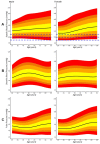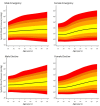Cross-sectional centiles of blood pressure by age and sex: a four-hospital database retrospective observational analysis
- PMID: 32376750
- PMCID: PMC7223140
- DOI: 10.1136/bmjopen-2019-033618
Cross-sectional centiles of blood pressure by age and sex: a four-hospital database retrospective observational analysis
Abstract
Objectives: National guidelines for identifying physiological deterioration and sepsis in hospitals depend on thresholds for blood pressure that do not account for age or sex. In populations outside hospital, differences in blood pressure are known to occur with both variables. Whether these differences remain in the hospitalised population is unknown. This database analysis study aims to generate representative centiles to quantify variations in blood pressure by age and sex in hospitalised patients.
Design: Retrospective cross-sectional observational database analysis.
Setting: Four near-sea-level hospitals between April 2015 and April 2017 PARTICIPANTS: 75 342 adult patients who were admitted to the hospitals and had at least one set of documented vital sign observations within 24 hours before discharge were eligible for inclusion. Patients were excluded if they died in hospital, had no vital signs 24 hours prior to discharge, were readmitted within 7 days of discharge, had missing age or sex or had no blood pressure recorded.
Results: Systolic blood pressure (SBP) for hospitalised patients increases with age for both sexes. Median SBP increases from 122 (CI: 121.1 to 122.1) mm Hg to 132 (CI: 130.9 to 132.2) mm Hg in men, and 114 (CI: 113.1 to 114.4) mm Hg to 135 (CI: 134.5 to 136.2) mm Hg in women, between the ages of 20 and 90 years. Diastolic blood pressure peaked around 50 years for men 76 (CI: 75.5 to 75.9) mm Hg and women 69 (CI: 69.0 to 69.4) mm Hg. The blood pressure criterion for sepsis, systolic <100 mm Hg, was met by 2.3% of younger (20-30 years) men and 3.5% of older men (81-90 years). In comparison, the criterion was met by 9.7% of younger women and 2.6% of older women.
Conclusion: We have quantified variations in blood pressure by age and sex in hospitalised patients that have implications for recognition of deterioration. Nearly 10% of younger women met the blood pressure criterion for sepsis at hospital discharge.
Keywords: ageing; blood pressure; hospitals; physiology.
© Author(s) (or their employer(s)) 2020. Re-use permitted under CC BY. Published by BMJ.
Conflict of interest statement
Competing interests: DW and PJW co-developed the SEND e-Obs system (for which Sensyne Health has purchased sole license) from which the study database was collected. The company has a research agreement with the University of Oxford and royalty agreements with Oxford University Hospitals NHS Trust and the University of Oxford. DAC is Research Director of Sensyne Health. PJW is employed part-time and holds shares in Sensyne Health. DW undertakes consultancy for Sensyne Health.
Figures




Similar articles
-
Accuracy Difference of Noninvasive Blood Pressure Measurements by Sex and Height.JAMA Netw Open. 2022 Jun 1;5(6):e2215513. doi: 10.1001/jamanetworkopen.2022.15513. JAMA Netw Open. 2022. PMID: 35671057 Free PMC article.
-
Folic acid supplementation and malaria susceptibility and severity among people taking antifolate antimalarial drugs in endemic areas.Cochrane Database Syst Rev. 2022 Feb 1;2(2022):CD014217. doi: 10.1002/14651858.CD014217. Cochrane Database Syst Rev. 2022. PMID: 36321557 Free PMC article.
-
Blood Pressure, Readmission, and Mortality Among Patients Hospitalized With Acute Kidney Injury.JAMA Netw Open. 2024 May 1;7(5):e2410824. doi: 10.1001/jamanetworkopen.2024.10824. JAMA Netw Open. 2024. PMID: 38739389 Free PMC article.
-
Blood Pressure Trajectories in the 20 Years Before Death.JAMA Intern Med. 2018 Jan 1;178(1):93-99. doi: 10.1001/jamainternmed.2017.7023. JAMA Intern Med. 2018. PMID: 29204655 Free PMC article.
-
Outcomes of Intensive Systolic Blood Pressure Reduction in Patients With Intracerebral Hemorrhage and Excessively High Initial Systolic Blood Pressure: Post Hoc Analysis of a Randomized Clinical Trial.JAMA Neurol. 2020 Nov 1;77(11):1355-1365. doi: 10.1001/jamaneurol.2020.3075. JAMA Neurol. 2020. PMID: 32897310 Free PMC article. Review.
Cited by
-
The importance of blood pressure measurements at the emergency department in detection of arterial hypertension.Cardiol J. 2024;31(4):596-602. doi: 10.5603/CJ.a2023.0026. Epub 2023 Apr 17. Cardiol J. 2024. PMID: 37067335 Free PMC article.
-
Is age associated with different vital signs in adults presenting to hospital with bacterial infection? A systematic review and meta-analysis.Age Ageing. 2025 Jul 1;54(7):afaf194. doi: 10.1093/ageing/afaf194. Age Ageing. 2025. PMID: 40698886 Free PMC article.
References
Publication types
MeSH terms
Grants and funding
LinkOut - more resources
Full Text Sources
Miscellaneous
